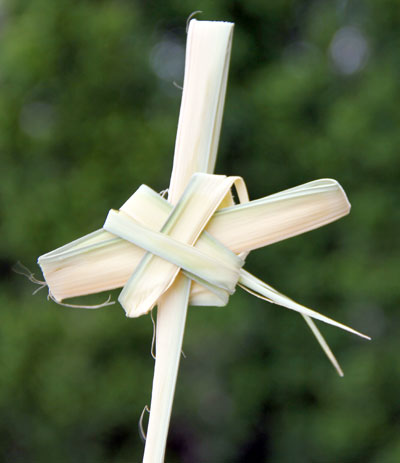Official Website of the
Catholic Diocese of Little Rock
The palm branch is a symbol of martyrdom
Published: April 8, 2025
Palm Sunday is celebrated the Sunday before Easter and marks the beginning of Holy Week. The procession for this Mass reenacts Jesus' triumphant entry into Jerusalem. In doing so we wave newly blessed palm branches and sing or cry out in some variation of "Hosanna!" "Blessed is he who comes in the name of the Lord!" "Hosanna in the highest!" (See Luke 19: 28-40 and Mark 11:1-10.)
Some may wonder, why palms? In Jewish tradition, palms were to celebrate triumph or victory. For Christians, the palm branch became a symbol of martyrdom. Even the words used to praise Jesus as he entered Jerusalem have deeper meaning. The Catechism of the Catholic Church explains that the word "hosanna" means "save" or "give salvation."
 "On Palm Sunday, we still go out to meet him, carry the blessed palms, joyfully sing out our hosanna and join in his triumphant entrance into Jerusalem," wrote D.D. Emmons for Simply Catholic. "But soon our joy turns to somberness as, clutching our palm, we hear the narrative of Christ’s passion. We realize, once again, that his triumph, his true victory, will come through the cross."
"On Palm Sunday, we still go out to meet him, carry the blessed palms, joyfully sing out our hosanna and join in his triumphant entrance into Jerusalem," wrote D.D. Emmons for Simply Catholic. "But soon our joy turns to somberness as, clutching our palm, we hear the narrative of Christ’s passion. We realize, once again, that his triumph, his true victory, will come through the cross."
This term along with the acclamation, "blessed is he who comes in the name of the Lord," is used during the Sanctus (Holy, Holy) of every Mass. It concludes the preface to the Eucharistic prayer "that introduces the memorial of the Lord's Passover. (catechism, no. 559)
The blessed palm frond that everyone receives at Palm Sunday Mass is a sacramental to take home. Traditionally Catholics keep their palms near or behind a crucifix, on a prayer altar or with their Bible. Keeping the palm serves as a reminder to remember Jesus' Passion and follow in his footsteps to carry the crosses in our own lives. Catholics are asked to bring their palms back a year later to be burned so the ashes can be used on Ash Wednesday to begin Lent anew.
For those who don't return their palms to be burned for Ash Wednesday and want to dispose of them properly, the same rule applies as with any blessed object. They should never be disposed of in the trash. The proper way is by burning or burial. With blessed palms, it would be appropriate to bury them in a flower garden at your home. From medieval times, people have believed that blessed palms formed into the shape of a cross would protect them from danger. To learn more, see the symbolism of palms in the ancient world or learn how to make a palm cross.




